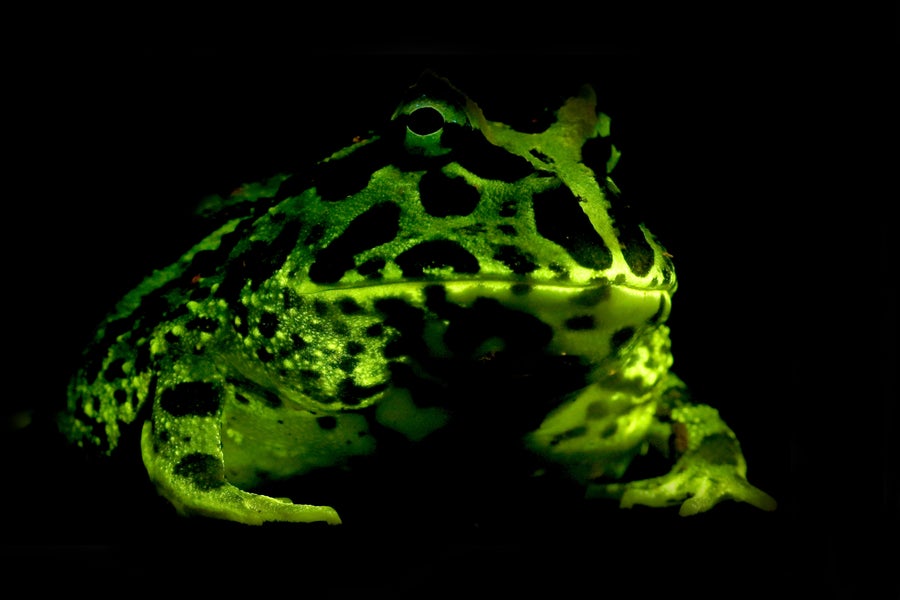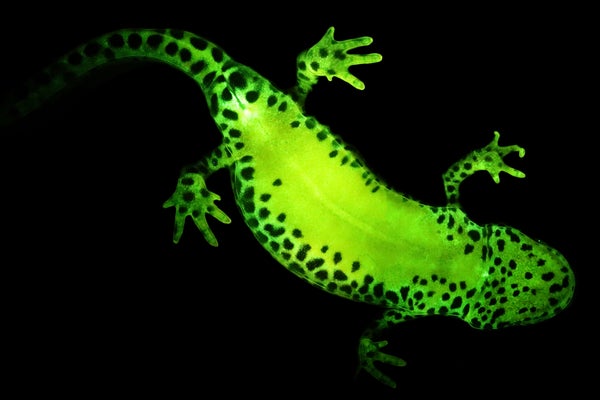With their quiet, often nocturnal lifestyles, salamanders may seem unimpressive at a casual glance. But seen in another light, they positively shine.
It turns out that salamanders—and many other amphibians—have the ability to reemit light they absorb, a feat known as biofluorescence, a new study finds. The work suggests the trait is far more widespread among these animals than anyone had thought. “Even in groups where you don’t have those bright, bold patterns—in animals that might be otherwise drably colored or mottled brown—you still get fluorescence to some degree,” says Jennifer Y. Lamb, a biologist at St. Cloud State University, who co-authored the study, published Thursday in Scientific Reports.
Biofluorescence happens when proteins or other cellular components absorb one wavelength of light and reemit it at a longer wavelength. Biologists have long known that marine creatures such as jellyfish have the ability, says study co-author Matthew P. Davis, who is also a biologist at St. Cloud State University. In the past half-dozen years, he and other scientists have found that many bony fishes can also produce this otherworldly glow.
On supporting science journalism
If you're enjoying this article, consider supporting our award-winning journalism by subscribing. By purchasing a subscription you are helping to ensure the future of impactful stories about the discoveries and ideas shaping our world today.
Terrestrial animals, though, have not been as thoroughly investigated for biofluorescence. A 2017 paper published in Proceedings of the National Academy of Science USA did find it in a polka-dotted South American tree frog. There had also been one report of fluorescence in the eastern red-backed salamander (Plethodon cinereus) published in 2018 in Herpetological Review. Given the limited research to date, Lamb and Davis wanted to take a closer look at amphibians’ abilities in this regard.

Green biofluorescence of amphibians like this Cranwell’s horned frog (Ceratophrys cranwelli) could help biologists spot species in dark conditions in the wild. Credit: Jennifer Y. Lamb and Matthew P. Davis
The two scientists took a more comprehensive approach to seeking out fluorescing species, studying specimens from the wild, in pet shops and at Chicago’s Shedd Aquarium. They tested 32 species of amphibians from eight families of salamanders, five families of frogs and one family of wormlike caecilians. The animals were exposed to both blue and ultraviolet light and observed for any brilliant patterns that might pop up. “You never knew exactly what you might get,” Davis says. It turned out that every species emitted a biofluorescent glow.
Sometimes the fluorescence was striking, as in the Eastern tiger salamander (Ambystoma tigrinum). In white light, its yellow-splotched black body is dramatic enough. When fluorescing, the blotches burst out in an otherworldly green. The Chinese fire belly newt (Cynops orientalis) lives up to its name with a vivid pattern of biofluorescence on its underside. And Typhlonectes natans, a plain brown caecilian that looks something like an earthworm on steroids, takes on a greenish-yellow glow. The presence of this fluorescence across families suggests it is a trait from the early evolutionary history of amphibians, the researchers say.
They also found that some amphibian larvae fluoresced, as did some species’ mucouslike secretions and urine. Even the fine bones of the toes of the marbled salamander, or Ambystoma opacum, lit up (this effect could be the result of minerals in the bones, Davis says). Proteins in the skin or secretions might explain some of the other fluorescence, according to Lamb.
It is possible that amphibians fluoresce under some natural conditions—especially at dawn and dusk, when the ambient light is predominately blue, Lamb says. Perhaps not coincidentally, dawn and dusk are when many amphibian species are most active, though the team does not yet know exactly how the animals use their glow. It might help them communicate or find mates, says Karen Lips, a biologist at the University of Maryland, who specializes in amphibians but was not involved in the new study. “I think that what this says is, ‘Wow, there is a lot of stuff going on that we haven’t noticed,’” she adds.
In that sense, biofluorescence may be a boon to wildlife biologists. Lamb notes that vegetation tends to fluoresce red under blue or ultraviolet light, whereas most amphibians fluoresce green. “It might be that we could use fluorescence in nocturnal surveys to try to detect some of these individuals as they’re active and going about their normal lives,” she says. If so, the secret lives of amphibians might reveal themselves in living color.
